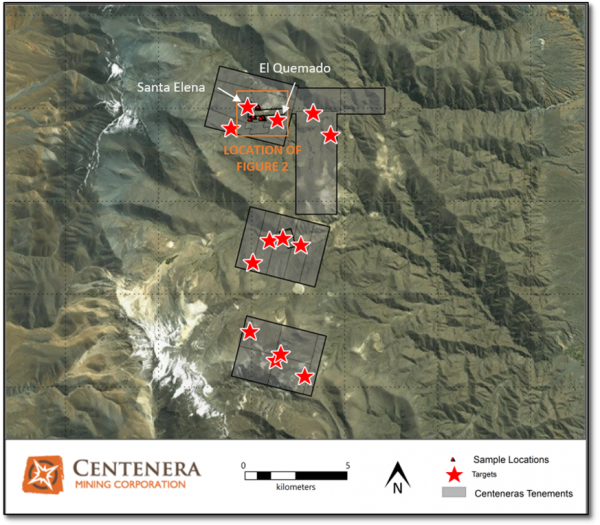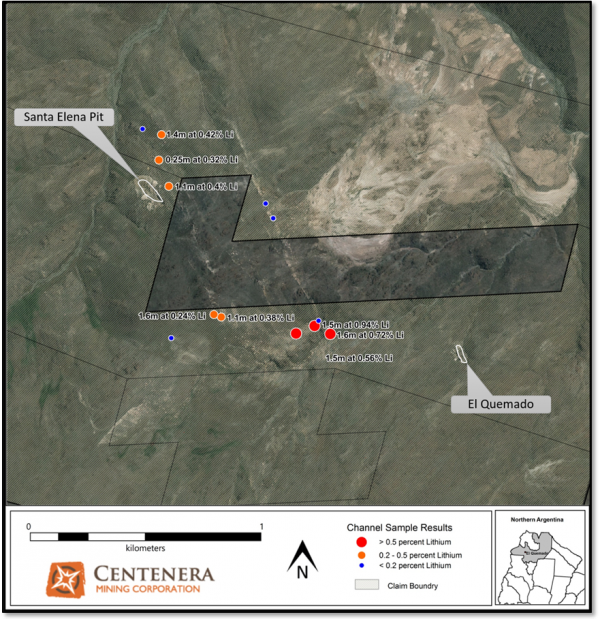Vancouver, British Columbia -- Centenera Mining Corporation ("Centenera" or the "Company") - (TSXV: CT, OTCQB: CTMIF), reports that it has received assay results from initial reconnaissance work at the Company's El Quemado Pegmatite Project (the "El Quemado Project"). The El Quemado Project includes a former tantalum-bismuth-producing mine site where lithium minerals were formally identified in 2012. This work provides the first recorded confirmation of lithium mineralization occurring beyond the historic pits. Having confirmed the viability of its exploration model, Centenera will now systematically test the remaining targets within the project area.
Sampling Results
Initial sampling focused on the area surrounding the historic El Quemado and Santa Elena mine sites where lithium mineralization is hosted in pegmatites. A total of eleven other targets have been identified within the El Quemado Project through analysis of high resolution satellite imagery, which allows areas of outcropping pegmatite to be easily identified (Figure 1).
A total of 13 rock chip surface samples were taken during the initial reconnaissance field campaign (Figure 2). The results confirm lithium mineralization in pegmatites surrounding the historical El Quemado and Santa Elena pits. Outcrop samples returned results ranging from below detection to a high of 0.94% lithium. In total, three samples returned lithium values grading between 0.56% and 0.94%, with an additional 5 samples returning values grading between 0.24% and 0.42% lithium. Samples were collected as chip channel samples across outcropping pegmatite veins and sample widths are reported together with grade in Table 1.
Table 1. Samples showing sample length and Lithium assay value
| Sample ID | Channel Length (m) | Lithium (%) |
|---|---|---|
| 403409 | 1.5 | 0.94 |
| 403411 | 1.6 | 0.72 |
| 403413 | 1.5 | 0.56 |
| 403516 | 1.4 | 0.42 |
| 403514 | 1.1 | 0.40 |
| 403506 | 1.1 | 0.38 |
| 403515 | 0.3 | 0.32 |
| 403507 | 1.6 | 0.24 |
| 403414 | 2.0 | 0.16 |
| 403412 | 0.3 | 0.09 |
| 403416 | 10.0 | 0.03 |
| 403517 | 1.7 | 0.03 |
| 403401 | 0.4 | 0.00 |
Planned Work
Academic workers in the area have reported that outcrop is rare and that most of the pegmatites are concealed by shallow cover. As a result the Company may need to employ soil geochemistry as well as outcrop mapping and sampling in order to define the full potential of the area. Individual outcropping pegmatite veins occur over a mapped strike length of up to 1.0km, but it has not been confirmed that pegmatites are continuous under cover or if lithium mineralization continues to occur throughout the belt. The next phase of work will seek to establish continuity and grade.
With lithium mineralization confirmed through the initial sampling, Centenera will move forward to fully assess the El Quemado Project. Planned work will include:
- Systematic mapping of all outcropping pegmatite targets identified from high resolution satellite imagery.
- Geochemical orientation sampling of selected pegmatite veins to quantify the impact of mineral zonation and to establish where lithium mineralization is focused within the pegmatites.
- Systematic channel sampling of each identified pegmatite to establish baseline grade and continuity of grade.
- Systematic soil sampling and analysis on areas where known pegmatites disappear under cover.

Figure 1: Overview of Centenera's tenements relative to surface samples collected and target areas for future work. Target areas are defined by probable cropping out of pegmatite rock.

Figure 2. Location of Samples, the Santa Elena Pit, and El Quemado Pit.
About Lithium - Lithium is produced from both brines and hard-rock sources (pegmatites). Estimates from 2015 put global lithium production from conventional hard-rock mining of lithium minerals as high as 44% (source: Macquarie research 2016). Lithium pegmatites are a viable source of the metal because of their high concentration in the ores relative to brines, and production from these deposits mitigates global concerns about dependence on supplies from dominant brine producers in Chile and Argentina. As a grade comparison, moderate to high brine grades of 400ppm lithium equate to 0.04% lithium, whereas initial sampling at the El Quemado Project has returned grades as high as 9,400ppm or 0.94% lithium. Chemical-grade lithium refers to spodumene that is converted to lithium carbonate or lithium hydroxide. Pegmatites are a source of technical-grade lithium, where spodumene is used directly in the ceramics or glass industries without processing.
About Pegmatites - Pegmatites are igneous rocks that form during the final stage of a cooling magma's crystallization. To be called a pegmatite, a rock should be composed almost entirely of crystals that are at least one centimeter in diameter. Most pegmatites have a composition that is similar to granite with abundant quartz, feldspar and mica. Pegmatites can be sources of valuable minerals such as spodumene (a lithium-bearing mineral) that are rarely found in economic amounts in other types of rocks. In the early stages of crystallization, the ions that form high-temperature minerals are depleted from the melt. Rare ions that do not participate in the crystallization of common rock-forming minerals become concentrated in the melt and in the excluded water. These ions can form the rare minerals that are often found in pegmatites. Examples are small ions such as lithium and beryllium that form spodumene; or large ions such as tantalum that form tantalite. Rare elements concentrated in large crystals make pegmatite a potential source of economic concentrations.
PDAC Conference
Centenera management will be attending the PDAC Conference in Toronto from March 5 to March 8 2017. Management looks forward to meeting shareholders at the Investors Exchange Booth 3346.
Quality Assurance/Quality Control
Rock chip samples from the initial reconnaissance work referred to herein were collected under the supervision of Company geologists in accordance with standard industry practice. Samples were dispatched via commercial transport to the SGS laboratory in Callao, Peru, an ISO 9001:2000 accredited laboratory, for analysis. Quality assurance and quality control procedures include systematic laboratory insertion of blanks, standards, and duplicates.
Qualified Person
Tyler Caswell, P.Geo., the Company's Exploration Manager and a qualified person as defined by National Instrument 43-101, has reviewed the scientific and technical information that forms the basis for portions of this news release, and has approved the disclosure herein. Mr. Caswell is not independent of the Company, as he is an employee and holds incentive stock options.
About Centenera Mining Corporation
Centenera is a mineral resource company trading on the TSX Venture Exchange, under the symbol CT and on the OTCQB exchange under the symbol CTMIF. The Company is focused 100% on Argentina with one copper-gold porphyry asset, three precious metals assets, a pegmatite asset and extensive exploration datasets. The Company's strategy is to acquire more high-quality mineral resource assets in Argentina. For more information on the Company's board of directors, management and assets, please refer to the Company's website at www.centeneramining.com.
On Behalf of the Board of Directors of
CENTENERA MINING CORPORATION
"Keith Henderson"
President & CEO
For further details on the Company readers are referred to the Company's web site (www.centeneramining.com) and its Canadian regulatory filings on SEDAR at www.sedar.com.
For further information, please contact:
Keith Henderson
Phone: 604-638-3456
E-mail: info@centeneramining.com
Neither TSX Venture Exchange nor its Regulation Services Provider (as that term is defined in the policies of the TSX Venture Exchange) accepts responsibility for the adequacy or accuracy of this news release.
This news release contains forward-looking statements and forward-looking information (collectively, "forward-looking statements") within the meaning of applicable Canadian and U.S. securities legislation, including the United States Private Securities Litigation Reform Act of 1995. All statements, except for statements of historical fact, that address activities, events or developments that management of the Company expects or anticipates will or may occur in the future including such things as the entry into of a definitive agreement in respect of the El Quemado Project, the exercise of the Option and the Company's exploration plans and schedule for the El Quemado Project, future capital expenditures (including the amount and nature thereof), business strategies and measures to implement strategies, competitive strengths, goals, expansion and growth of the business and operations, plans and references to the future success of the Company, and such other matters, are forward-looking statements. Often, but not always, forward-looking statements can be identified by words such as "pro forma", "plans", "expects", "may", "should", "budget", "scheduled", "estimates", "forecasts", "intends", "anticipates", "believes", "potential" or variations of such words including negative variations thereof, and phrases that refer to certain actions, events or results that may, could, would, might or will occur or be taken or achieved. Forward-looking statements involve known and unknown risks, uncertainties and other factors which may cause the actual results, performance or achievements of the Company to differ materially from any future results, performance or achievements expressed or implied by the forward-looking statements. Such risks and other factors include, among others, operating and technical difficulties in connection with mineral exploration and development and mine development activities at the El Quemado Project, actual results of exploration activities, estimation or realization of mineral reserves and mineral resources, the timing and amount of estimated future production, costs of production, capital expenditures, the costs and timing of the development of new deposits, the availability of a sufficient supply of water and other materials, requirements for additional capital and the timing and availability of same on acceptable terms, future prices of precious metals, tantalum and lithium, changes in general economic conditions, changes in the financial markets and in the demand and market price for commodities, possible variations in ore grade or recovery rates, possible failures of plants, equipment or processes to operate as anticipated, accidents, labour disputes and other risks of the mining industry, delays in obtaining governmental approvals, permits or financing or in the completion of development or construction activities, changes in laws, regulations and policies affecting mining operations, hedging practices, currency fluctuations, title disputes or claims limitations on insurance coverage and the timing and possible outcome of pending litigation, environmental issues and liabilities, risks related to joint venture operations, and risks related to the integration of acquisitions, as well as those factors discussed under the heading "Risk Factors" in the Information Circular dated April 28, 2016, as amended, and discussed in the annual management's discussion and analysis and other filings of the Company with the Canadian Securities Authorities.
Readers are cautioned not to place undue reliance on forward-looking statements. The Company undertakes no obligation to update any of the forward-looking statements in this news release or incorporated by reference herein, except as otherwise required by law.
